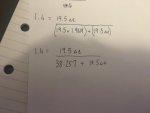Hello,
I am a first time poster. The last time that I did maths was around 14 years ago at school, now I have gone back to Uni to study a Masters in Engineering Geology and I am struggling with rearranging equations.
This equation here is to help me know the change in the void ratio of a soil (Delta e).
I would like help to show me how to get to Delta e.
My equation so far is:
1.4=(Delta e/1.9619 + Delta e) * 19.5
Could someone please walk me through this?
Thank you.
I am a first time poster. The last time that I did maths was around 14 years ago at school, now I have gone back to Uni to study a Masters in Engineering Geology and I am struggling with rearranging equations.
This equation here is to help me know the change in the void ratio of a soil (Delta e).
I would like help to show me how to get to Delta e.
My equation so far is:
1.4=(Delta e/1.9619 + Delta e) * 19.5
Could someone please walk me through this?
Thank you.


